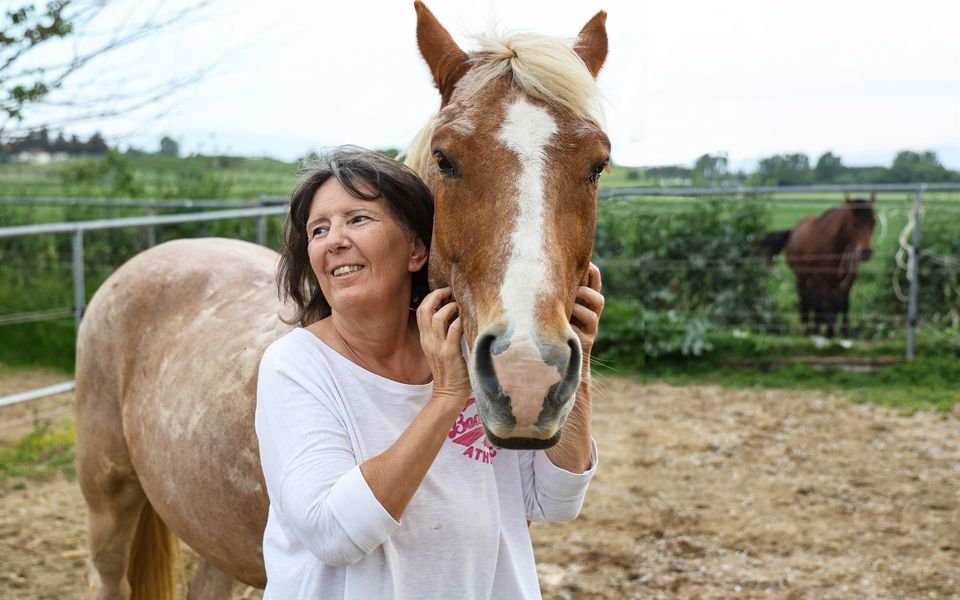It was only my second time on horseback, so I was feeling skittish. But Jerry, thankfully, is by no means new to nervous newbies. Aged 16, he’s an old hand at giving rides to children, teenagers and adults with physical, mental and emotional disabilities, ranging from the mild to the severe. Maria Linga, a physical therapist specializing in equine-assisted therapy (EAT), held the reins as I mounted and told me the story of the Serres Therapeutic Riding Center. As I listened to the enthusiastic narrative of the center’s chairman and co-founder, I could not help feeling that photographer Nikos Kokkalias and I were somewhere special, that Serres is good for the soul, and that its people are different somehow. “We’re talking about Macedons, my dear! Everyone is welcomed and looked after, because the people here know all about uprooting and hardship; they have been through a lot,” said Maria, full of pride. “That is why they embrace progress and act with compassion and solidarity.”
Maria and a group of colleagues from a special needs school founded the Serres Therapeutic Riding Center 20 years ago and turned it into a paradigm whose reputation stretches across northern Greece and beyond.
“We’ve seen actual miracles happen here – not only in terms of patients’ physical mobility, but above all in their psychological well-being. You see, a horse moves with the same gait as a human, so when someone who cannot walk gets on a horse, they experience the sensation of moving their legs. They are lifted out of the wheelchair and get to see the world in motion, from up high,” said Maria as we watched the sun set over the farm in the village of Neos Skopos, where sick and abused horses and donkeys are also given a safe home.
“We were lucky because the first mayor we pitched our idea to, Vassilis Ketsetzis, was a physical therapist by profession and immediately understood what we were trying to do. Without this support, without the volunteers and the sponsors, we never would have succeeded. All the local government leaders stood by our side and continue to do so, at first by giving us the space, then free electricity and water, not to mention the indoor riding paddock. Greece only has two, this one and the one in Markopoulo [in Attica],” she added.
The wetland
We followed our visit to the riding center with an excursion to the Kerkini Lake wetland, one of the few areas in the region that is properly organized and managed, including as a tourist attraction – another small miracle. Yiannis Savvidis captained our boat as he shot off information in Spanish and French to our fellow passengers. Raised in Belgium by Greek migrant parents, he returned to his native Serres and now works for Oikoperiigitis, an ecotourism company founded by Yiannis Reklos, a pioneer of the sector who also established the Ecological Tour Center of Kerkini, which now includes hospitality, accommodation and dining facilities.
Reklos grew up near the lake and was interested in ensuring that visitors would enjoy the lake’s attractions while respecting the ecosystem. “Back when it all started, with a running race around the lakeshore, in 1982, everyone thought I was nuts. But I loved this place and I wanted others to see its beauties too. But I also wanted to see it developed the right way,” said Reklos, whose efforts were instrumental in making the locals more aware of the wetland’s value.

 The Papadopoulos family has made a successful venture of Kerkini Farm, where they raise and process buffalo meat. It all started with a butcher shop and 10 heads of cattle. [Nikos Kokkalias]
The Papadopoulos family has made a successful venture of Kerkini Farm, where they raise and process buffalo meat. It all started with a butcher shop and 10 heads of cattle. [Nikos Kokkalias]
He was joined in these efforts by Vassilis and Eleni Papadopoulos, the husband-and-wife team behind Kerkini Farm, a venture that began with 10 animals and has now grown to 300. Together with their children Klenathis and Stavros they have created a model, vertically integrated farm for raising and processing buffalo meat, an operation that has been awarded by Kathimerini’s Gastronomos food magazine.
“Eleni and I hail from Pontus and Thrace, respectively, but we grew up here. We spent a few years in the Netherlands but came back because we love this place. Marrying the buffalo to Kerkini is one of our proudest achievements. It took a lot of hard work, patience and faith; we weren’t investors who had the money and just sat back and watched it all happen. We built everything step by step, starting with a butcher shop. The other achievement we are very proud of is the fact that we managed to keep our children here,” said Vassilis Papadopoulos, to have Kleanthis and Stavros add: “We loved this work even as boys because we were always right here beside them. We saw that they were happy and now our children see that we’re happy too.”
The exodus
The two young men are an exception among their peers, most of whom have left Serres, mainly for Thessaloniki and Athens, but also abroad. Serres is, in fact, one of the regions that has seen the greatest declines in its resident population in recent decades. One after another, villages and hamlets are being abandoned despite beautiful natural surroundings that could, potentially, have made them a tourist magnet, providing year-round revenue. One of the few villages that has bucked the trend is Ano Poria, and that’s thanks to Lake Kerkini and the buffalo farm. It is also a popular stop for visitors looking for a bite to eat.
We met two women there who came to Serres as brides and went on to set up the Niviasta women’s cooperative, which boasts a lovely location overlooking the lake and serves delicious food and desserts. “‘Niviasta’ is a Vlach word that means bride and once you settle in a Vlach village you soon become a deft hand at making pies,” said Danae Filiou and Athina Arianopoulou, who set up the cooperative after their children left for university and they found themselves with too much free time on their hands.
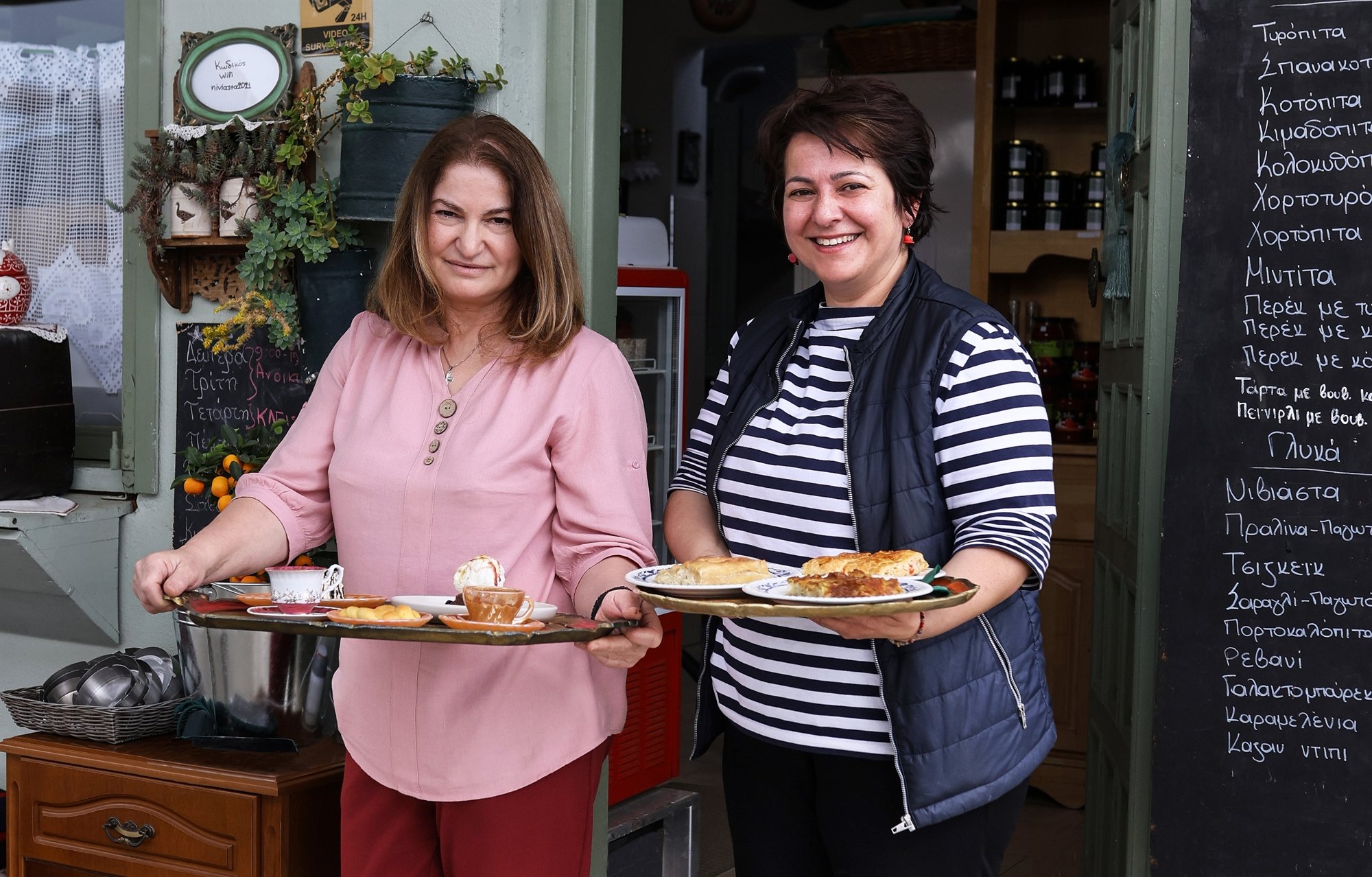
 Athina Arianopoulou (left) and Danae Filiou are among the founding members of the women’s cooperative Niviasta, in the village of Ano Poria. [Nikos Kokkalias]
Athina Arianopoulou (left) and Danae Filiou are among the founding members of the women’s cooperative Niviasta, in the village of Ano Poria. [Nikos Kokkalias]
Such initiatives are few and far between, though. One exception is the fish shop and taverna run by the Tasis family near the village of Agistro on the Greek-Bulgarian border. “We hail from Epirus. I came here in my 30s and have now been here for 45 years,” said Giorgos Tasis.
“The area has changed for the better. It used to be a strictly controlled border zone, but that stopped in the early 1980s. That, in combination with the hot springs of Agistro, gradually turned the tide and tourists gradually started coming. We’re right beside one of the main overland gateways into the country and even though so many people pass through here, few actually stop, even though we have some real gems,” he added.
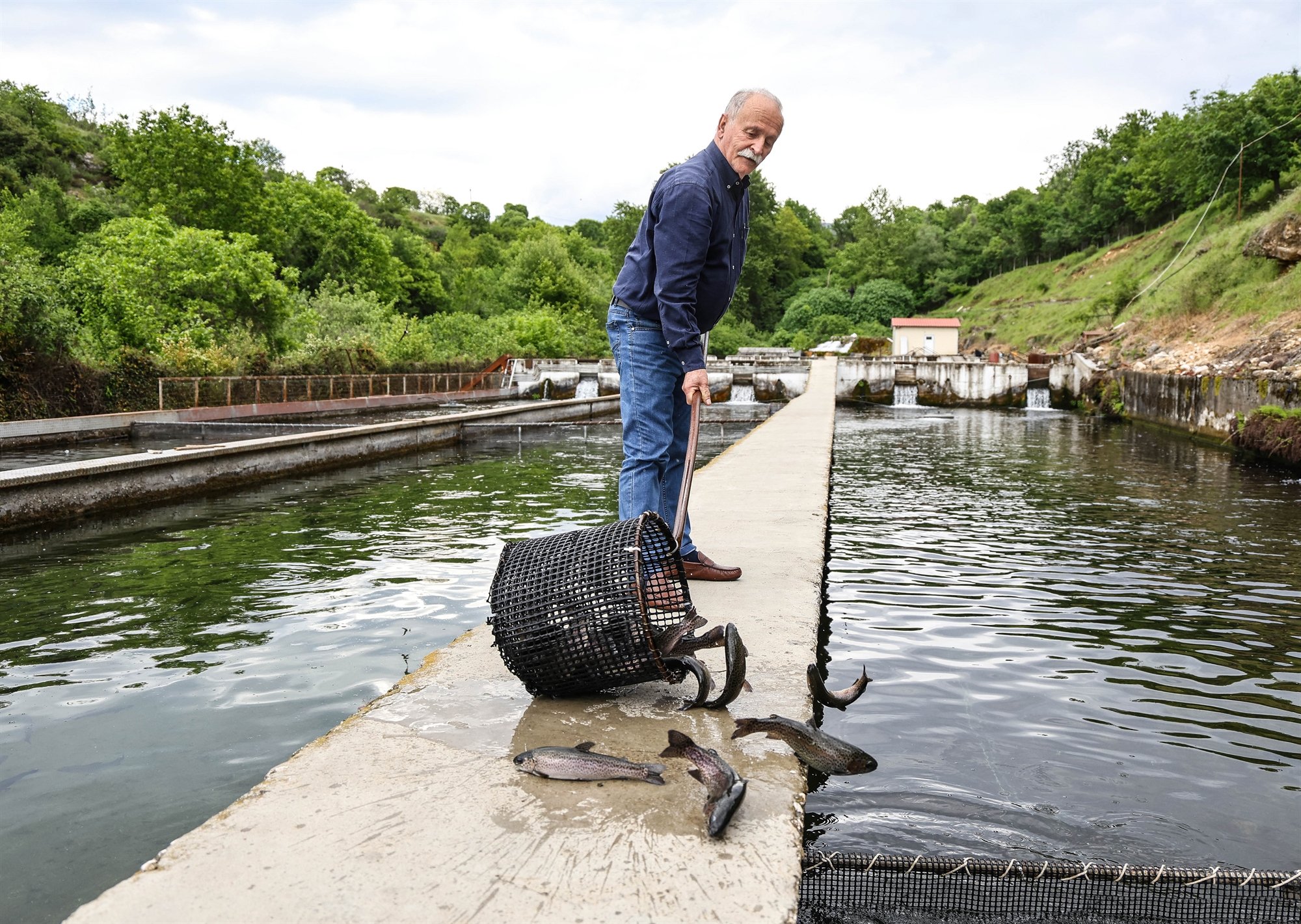
 Trout farmer and restaurateur Giorgos Tasis moved from Epirus to the border village of Agistro with his father more than 40 years ago. [Nikos Kokkalias]
Trout farmer and restaurateur Giorgos Tasis moved from Epirus to the border village of Agistro with his father more than 40 years ago. [Nikos Kokkalias]
The truth is that most of the cars we saw between the border crossing at Promachonas and the city of Serres had Bulgarian number plates. Northern Greece is a very popular destination for the Bulgarians who now come here in droves as tourists; there was a time, however, when they came as invaders. Few Greeks know that the city was burned down in the early 20th century. “Serres is a city with post-traumatic stress. It’s suffered through three brutal Bulgarian occupations; the first in 1913, when it was destroyed, and then again in 1916 and 1941. It also saw some nasty fighting in the civil war,” said writer Vassilis Tzanakaris, the voice and pen of Serres’ history, the living conscience of a past full of shadows that still linger over this part of northern Greece.
We met him at his apartment in the city, where he’s managed to squeeze his considerable archive and library into a few dozen square meters. He explained that Serres was not just physically wiped out by the fire, but it also lost its leadership, not two, but three times over, as well as a large part of the population, which fled. “Many Serres natives fled in the third occupation because they had a bitter experience of the Bulgarians and they never came back even after the city was liberated. That was not the case with residents who had settled here as refugees from Pontus, Asia Minor and Cappadocia, nor the Sarakatsani and the Vlachs, who stayed because they didn’t know just how harsh the occupiers could be. As a result, Serres does not have a museum dedicated to its history, nor families with deep, multi-generational roots. Distinct refugee identities prevail instead, and these are honored and preserved by local cultural associations,” said Tzanakaris.
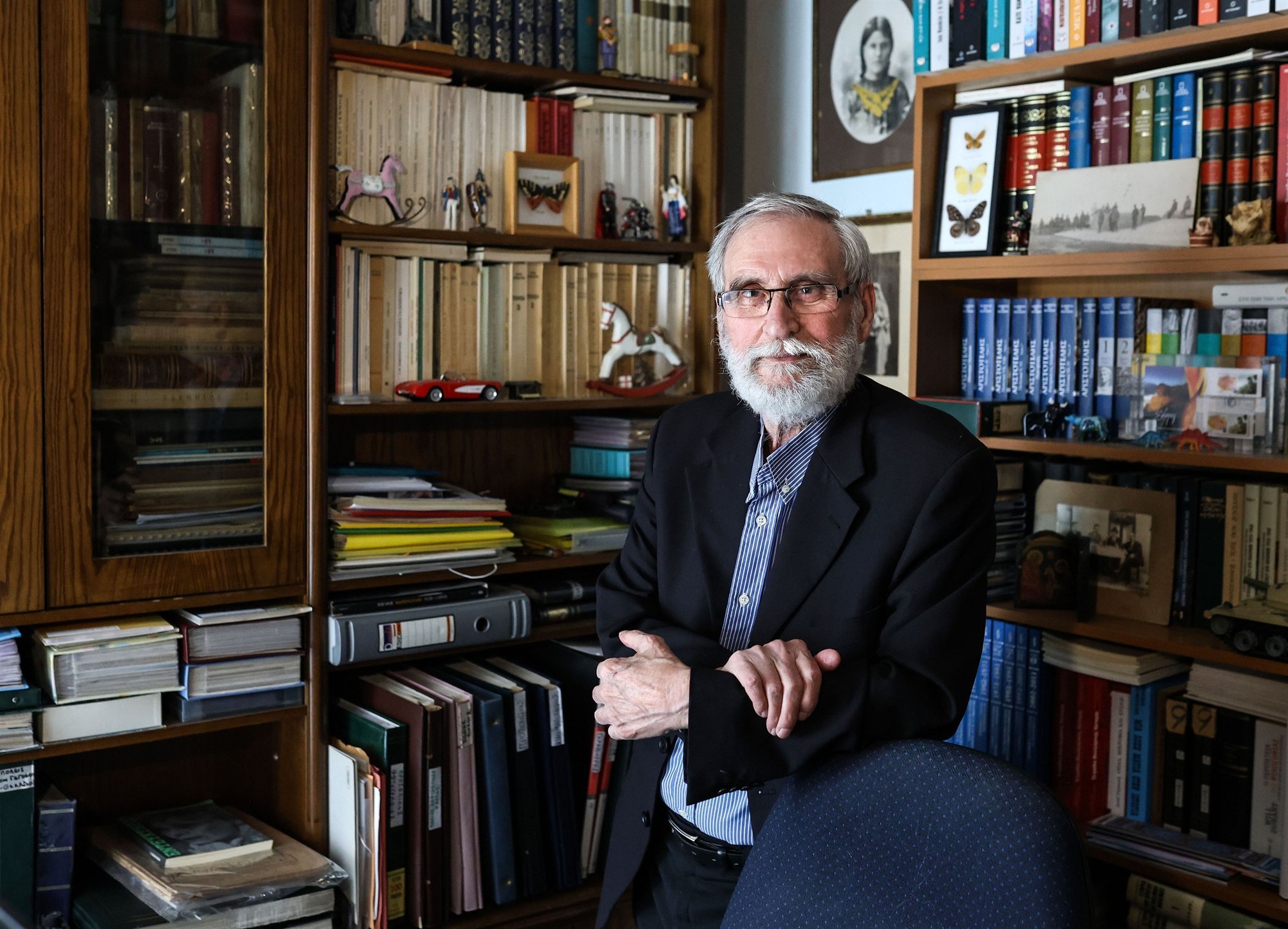
 Writer Vassilis Tzanakaris is Serres’ living memory, having created an extensive archive on the region’s history containing rare documents and photographs, which he keeps in his apartment. [Nikos Kokkalias]
Writer Vassilis Tzanakaris is Serres’ living memory, having created an extensive archive on the region’s history containing rare documents and photographs, which he keeps in his apartment. [Nikos Kokkalias]
“Historical memory is absent, in the city and in the region. And this is more than evident by the fact that people whose forefathers were tortured by the Bulgarians have no problem selling their homes to buyers from the neighboring country. And the reason is that the region is being deserted as a result of the tobacco fields being abandoned by the second and third generations that gave up farming and other professions, and the older generations being unable to resist the money that is being offered to them,” he added.
“Serres is sandwiched between Bulgaria and Thessaloniki, and this is what determines the city’s fate. The traces of the three occupations are still fresh, but historical memory is cast aside when financial gain is involved. Houses are being bought up by Bulgarians at exorbitant prices, possibly because it’s a way of laundering money, but also because Bulgarian banks used to hand out loans for such purchases very easily,” Dimitris Natsios, a journalist at the Lion News website, told us.
“Serres’ vitality once came from its fertile plain. Farmers supplied the city, but when tobacco cultivation ended, the local economy never fully recovered. The region also produced tomatoes, corn, sugar beets and rice. There were even processing plants – like the Hellenic Sugar Industry – up until around 1990. I remember picking tomatoes with my mother when I was about 10 or 11. Back then, a small-scale farmer with around 2.5 hectares could afford to buy an apartment after a few years. Those days are long gone,” he added.
There are those, however, who are making a go of it, despite the challenges.
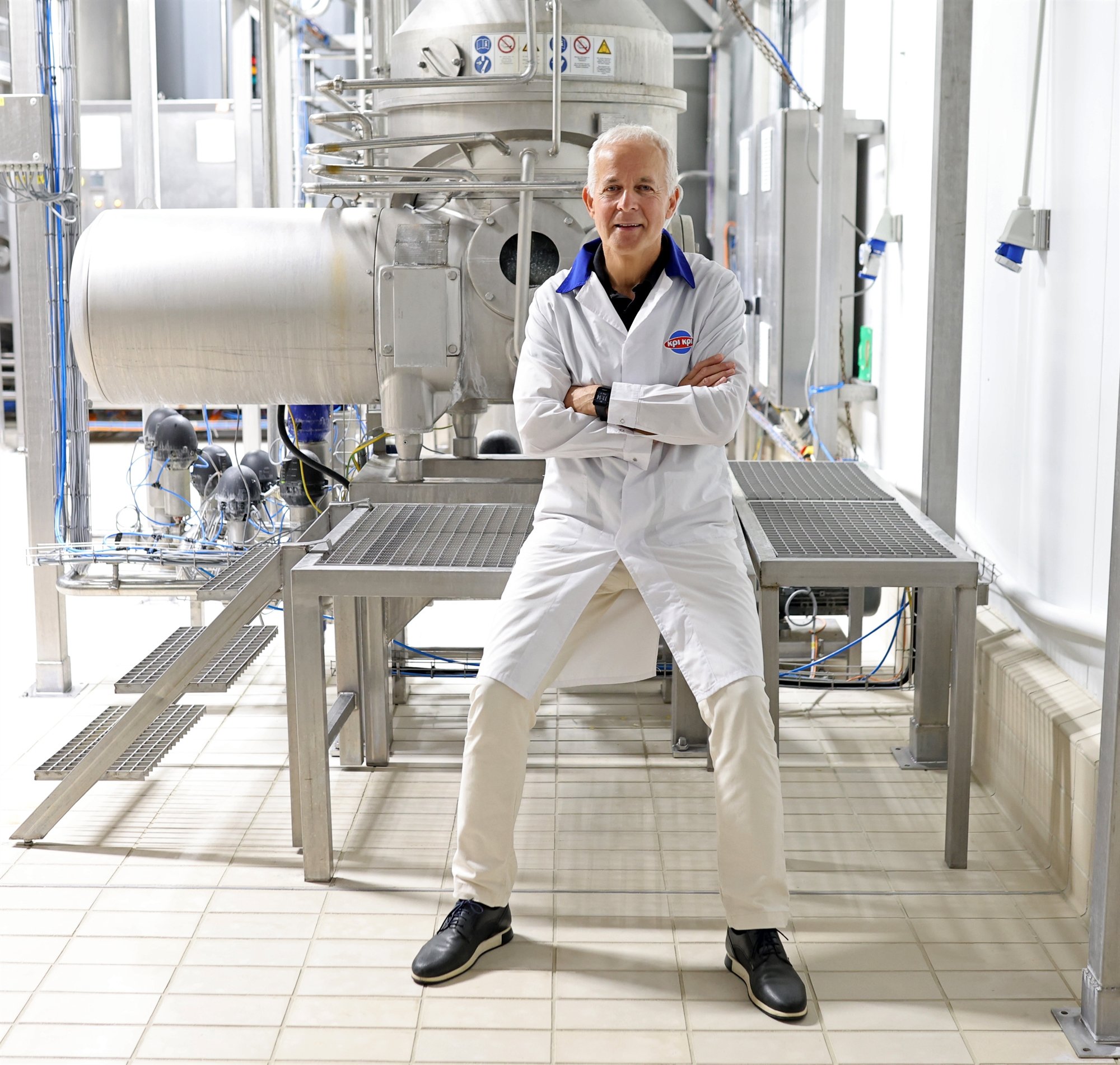
 Panagiotis Tsinavos continues to evolve the dairy company Kri-Kri, which was founded by his father and uncle. [Nikos Kokkalias]
Panagiotis Tsinavos continues to evolve the dairy company Kri-Kri, which was founded by his father and uncle. [Nikos Kokkalias]
We met businessman Panagiotis Tsinavos at the plant of his successful dairy company, Kri-Kri, where he has also created an excellent and very popular ice cream museum. He was due to meet with a group of farmers at the academy the company has set up. “We buy 300 tons of milk a day, but we also train the producers we work with so that they can become better and more efficient,” he explained.
Kri-Kri was started by his father and uncle. “In 1987 we decided to carry on the business, not as representatives, but with a view to creating a small, modern processing facility. We got into the milk industry in 2001 and were listed on the Athens Exchange in 2003, when we also expanded into yogurt. Thanks to our sound strategy, we now have more than 50% of the Greek market share, while 60% of turnover comes from exports, mainly to the UK and Italy. We leveraged our advantage, as the Serres region produces the highest percentage of cow’s milk in the country, so we collect and process it within 24 hours,” explained Tsinavos, whose plant also produces yogurt for the British supermarket chain Waitrose under its private label.
“Our most important component, however, is our 700-strong workforce. In the countryside, you can either look for people or you can create them, and if you invest in them, they will give themselves to you, heart and soul. Healthy entrepreneurship cannot rely on subsidies. Many industrial areas have turned into graveyards. The state needs to create a functional environment where real business competition can thrive, without bureaucratic obstacles. We love Serres – we live here, we produce here. Some say our disadvantage is being situated between Thessaloniki and Bulgaria. But if you look at it from a production and export perspective, we’re actually in a strategically privileged position on the map,” he added.
The racetrack
Another avenue for development is the racetrack, which is owned by the municipality. We were shown around by its director, 30-year-old Yiannis Koteoglou, who began racing go-karts at the age of 6. He has been CEO for the past year and a half. “Not being close to Athens is actually an advantage, because we’re near the borders and attract visitors from Bulgaria, Romania and Turkey. We have access to the Balkan market, and one of our key assets is the favorable climate. We’re also looking to extend the track. If that happens, we’ll be on par with international racetracks. When there’s a major international event, 5,000 to 6,000 people come and stay for several days. I feel a responsibility to succeed so we can create more jobs in the region,” he said.
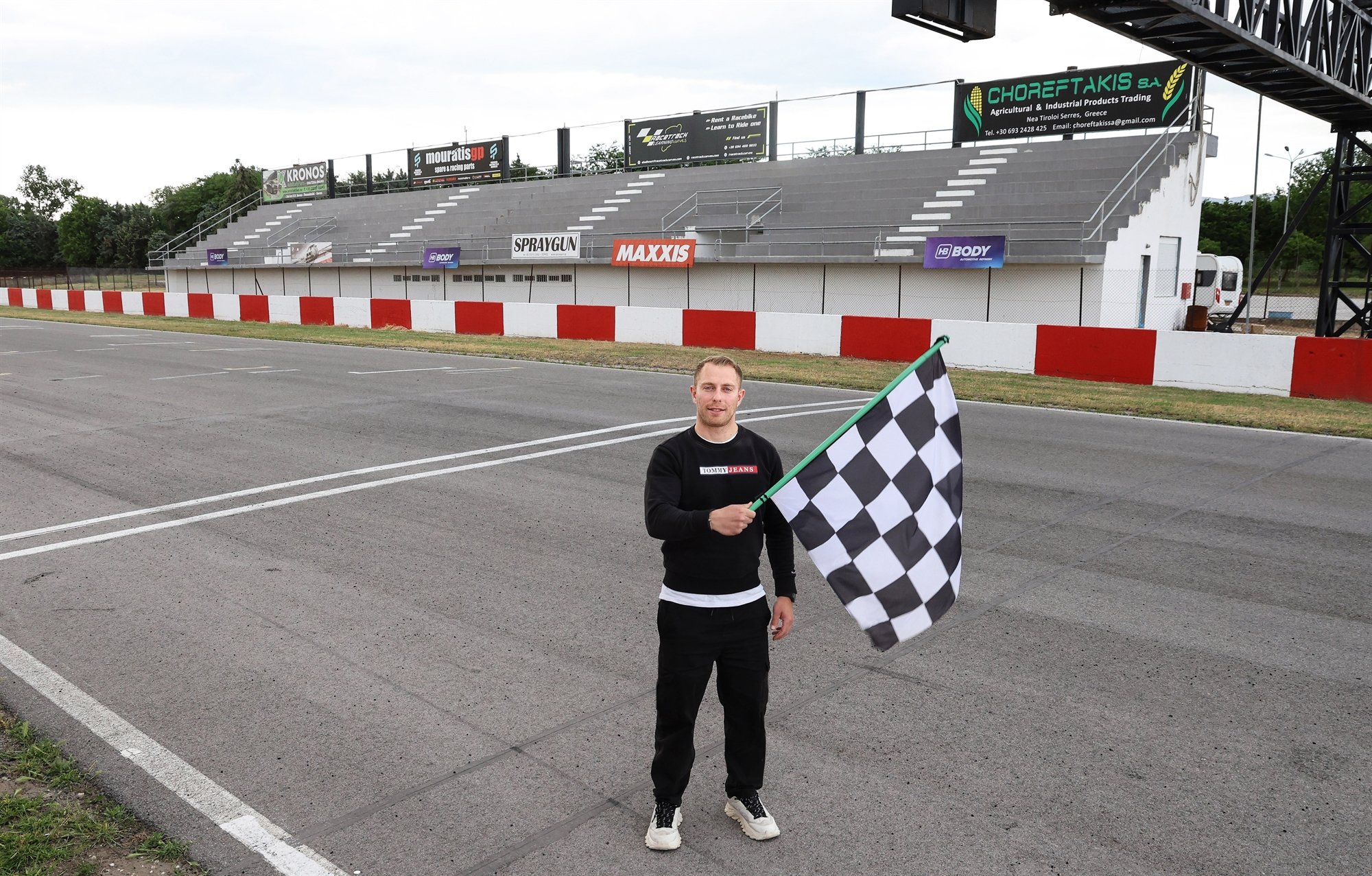
 As manager of the racetrack, Yiannis Koteoglou is doing exactly what he always wanted to do. The 30-year-old is one of the few Serres locals who made his childhood dream come true. [Nikos Kokkalias]
As manager of the racetrack, Yiannis Koteoglou is doing exactly what he always wanted to do. The 30-year-old is one of the few Serres locals who made his childhood dream come true. [Nikos Kokkalias]
Turning the tide
Serres has found an unexpected champion in its effort to reposition itself on the Greek tourism map: Giorgos Kapoutzidis. The popular actor, screenwriter and television host always “advertises” his roots, while he also wrote a TV series, “Serres,” that was filmed there. He is currently working on the show’s second season, so we were able to meet up with him in the city. “It’s wonderful to love the place where you come from. For me, it is a piece and a part of my journey. When I realize how far it is from Athens, I have to say, I give myself a bit of a high-five. My path to a television career was a lot longer than that of an Athenian,” he said.
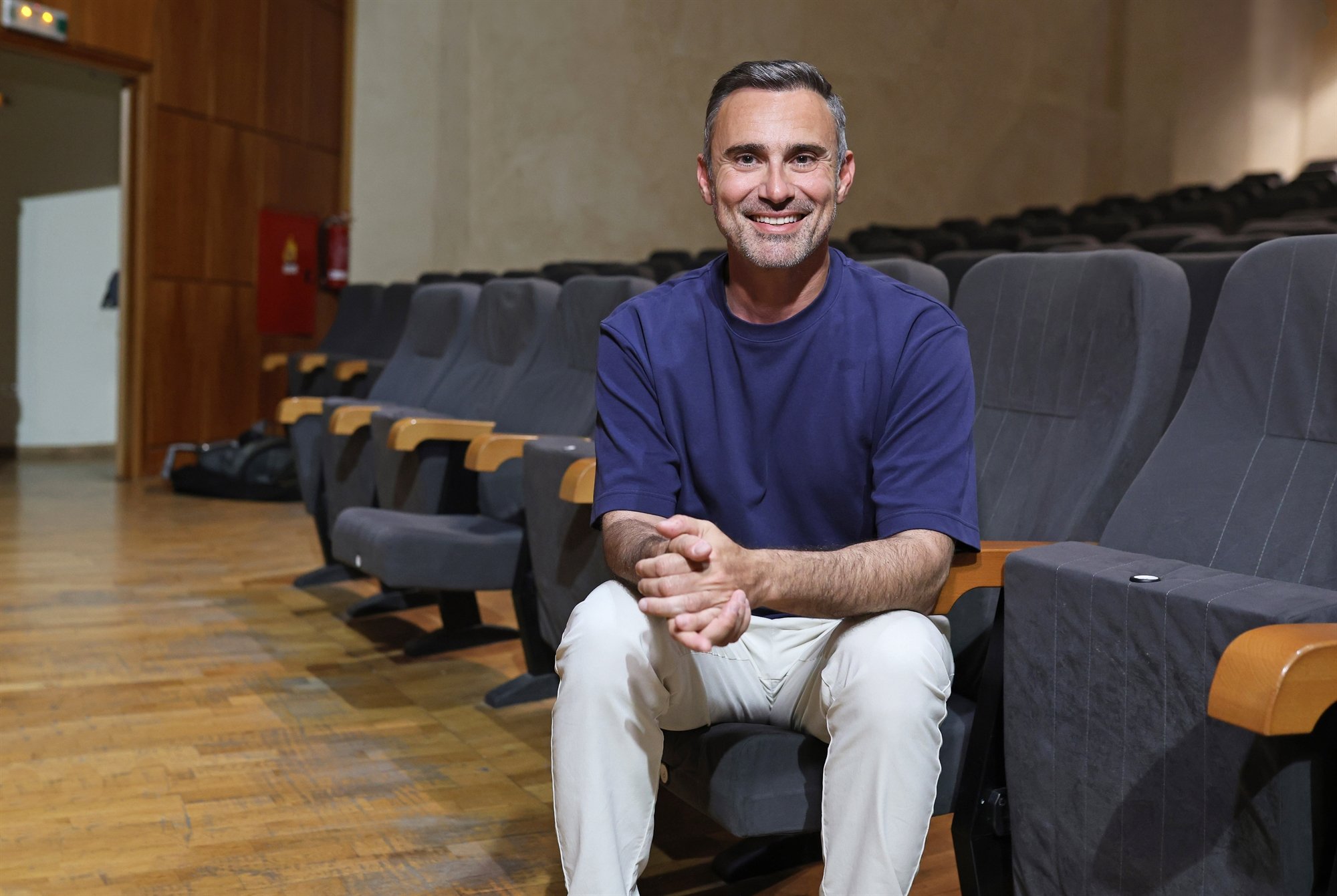
 Giorgos Kapoutzidis, a popular actor, screenwriter, and television host, proudly highlights his roots. He even wrote a TV series, ‘Serres,’ which was filmed there. [Nikos Kokkalias]
Giorgos Kapoutzidis, a popular actor, screenwriter, and television host, proudly highlights his roots. He even wrote a TV series, ‘Serres,’ which was filmed there. [Nikos Kokkalias]
“Like any kid, I thought Serres was the center of the universe when I was growing up here. But it was a wealthy region back then. People lived well and partied a lot. Serres was a very lively city in the 1990s, with lots of people out in the streets, lots of cafes and bars. The truth, though, is that I was at home; I don’t remember going out for fun with friends. When I understood what I was – my sexuality, I mean – I shut myself in my room; it’s something I simply cannot describe. The show describes some of the difficulties that all gay people and especially homosexual boys growing up in a provincial city have to deal with. But if there is one thing I wish for my city, it’s that it gets its joie de vivre back, that it prospers.”
The soccer team
Before Kapoutzidis, it was the Panserraikos soccer team that got Serres onto people’s televisions, according to veteran Takis Iliadis, one of Greek soccer’s famed midfielders. He played at club level from 1964 to 1976. “Right here is where I beat the ‘Bird,’ [Takis] Oikonomopoulos, with a straight shot from the corner of the post,” he reminisced as he showed us around the soccer stadium.
“Back when I was a kid, we’d save up our caroling money to buy a soccer ball and we’d play on dirt; there were empty lots all over the place. The first time we, the players of Panserraikos, went to play in Athens, at the Karaiskakis Stadium, in 1965, and saw the pitch all lit up with those huge lights, we thought we’d gone to space. And when an away team came here to play, it wouldn’t just be the coach and the players – among which were some greats, like [Mimis] Domazos – but also hundreds of fans from every corner of the country. We had 3,000-4,000 people from Piraeus once when Olympiakos came to play. Our team became an advertisement for Serres, unbeknownst to us.”

 Panserraikos veteran Takis Iliadis, one of Greek soccer’s legendary midfielders, pictured at the local home ground. [Nikos Kokkalias]
Panserraikos veteran Takis Iliadis, one of Greek soccer’s legendary midfielders, pictured at the local home ground. [Nikos Kokkalias]
So, what kind of city is Serres, at the end of the day? The artistic director of the Regional Municipal Theater of Serres and composer Giorgos Andreou puts it best.
“It’s only natural for the dominant narrative to be about the city’s decline; this is the case with almost every inland city and town in Greece, which found themselves bereft of a role, defenseless, once agriculture and manufacturing disappeared or dwindled, and residents started leaving. Look at the case of Serres; the population in the region has gone down from 214,000 [in 2011] to 150,000 [in 2021], and it’s still dropping. The city used to be the sixth most prosperous in Greece and now it ranks in 52nd place. We tour the provinces in the summer, putting on shows in villages and in many of the smaller and more isolated communities, where we rarely play for anyone under the age of 65,” said Andreou, whose father had served as the city’s mayor for successive terms and is regarded as one of its benefactors.

 Giorgos Andreou is the artistic director of the Regional Municipal Theater of Serres, which tours the countryside in the summer, often performing in villages where no one is under the age of 65. [Nikos Kokkalias]
Giorgos Andreou is the artistic director of the Regional Municipal Theater of Serres, which tours the countryside in the summer, often performing in villages where no one is under the age of 65. [Nikos Kokkalias]
For his part, the younger Andreou has turned the theater company into an integral part of city life by transforming its headquarters into a cultural center hosting all sorts of activities all year round.
Andreou believes that northern Greece has enormous potential that is going untapped. “Precisely because the populations here were – and remained – multicultural for at least a hundred years after the formation of the modern Greek state, they learned to coexist. Let me explain from the musician’s standpoint. I studied piano at the conservatory during the dictatorship under an incredible pianist who had come to Serres from the Mozarteum [University in Salzburg] for personal reasons. That was an incredible stroke of luck. Serres also has a very rich folk music tradition, where refugee and local influences are intertwined. On one side, you have Pontians, Vlachs and Asia Minor Greeks; on the other, in certain areas, you have Roma musicians who play soul-stirring zurna and a type of bagpipe. At the conservatory, I was learning Beethoven, Mozart and Chopin; outside it, I was hearing this tangled blend of tradition. We’re a mosaic whose pieces were never fully fused together, and that’s the beauty of this place, its diversity. Southern Greeks, who tend to dominate the historical narrative, find it hard to grasp that here in the north, the influences are Balkan and Central European; they are not drawn from Elytis’ Aegean. Only [Theo] Angelopoulos truly understood this quality, which is why he filmed ‘The Weeping Meadow’ at Lake Kerkini.”
